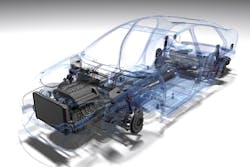A very competent mechanic I work with recently described a troubling situation he encountered. Our collision shop had completed a collision repair and he was road testing the vehicle prior to performing a wheel alignment and final scan of the electronics.
It was a relatively new hybrid. There were no dash warning lights illuminated. The vehicle went down the road nicely. The steering wheel was centered and the front end did not pull to the right or left.
Want to Meet Darrell Amberson?
-
He’s leading a session at the FenderBender Management Conference Sept. 19–21 in Chicago and will be available for questions and discussion.
While traveling down the freeway in the right lane, another vehicle came up at a faster speed in the left lane, going the same direction, and was about to pass. As the accident avoidance system detected the other vehicle, all of a sudden the steering wheel turned to the right.
It was not a violent move and our technician was able to hold the wheel straight. Our tech was surprised and wondered if it was his imagination. He returned to the shop and asked another tech to accompany him to replicate the situation. It performed the same, thus verifying his observation.
Our tech performed a scan and found a fault code indicating that the steering angle sensor was not properly calibrated. He performed the calibration and the wheel alignment. The problem was cured. The out-of-calibration sensor was causing the module to believe that the vehicle was headed to the left and it turned the steering wheel to the right to avoid the oncoming car. Scary situation. Thank goodness it was detected before returning the vehicle to the customer, as one could only imagine the potential consequences.
This is an example of many potential issues related to not adequately diagnosing and calibrating the complex electronic systems on today’s vehicles. More and more, industry experts and OE manufacturers are at least recommending pre- and post-repair scans. Some are going beyond the term “recommend” and stating that the process should be mandatory. At an industry event earlier this year, an OE manufacturer representative stated, “I wonder if the term ‘recommend’ is costing lives or saving money.”
As collision repairers, it is our responsibility to repair vehicles to their original appearance and function. I would like to think we all agree on that. Yet I know from experience that many insurance company representatives have not been trained on these systems. In many cases they are skeptical about what we repairers say needs to be done. Factory repair information, I-CAR, ALLDATA, and other sources provide the necessary ammunition for verification. Yet we often get pushback. Ever hear the phrase, “You’re the only one?” As an industry we can be slow in adapting to new repair procedures and methodology, and even slower in establishing norms for shop compensation.
Each of us as repairers will need to decide how we will approach the situation if we perform scans and/or calibrations and an insurer refuses to pay for it. The 2016 CCC Crash Course, an annual industry report based on CCC’s data, states the following:
“All vehicles with collision avoidance require recalibration if engaged during an accident. Some additional labor operations are available with suggested labor times in the Motor GES database; typically listed as labor time to ‘add for distance sensor’ and/or ‘aim distance sensor.’ … What is often not included, but is often another set of labor operations required when the crash avoidance and warning systems have been triggered, is the reset and clearing of codes in the Powertrain Control Module (PCM) and the Restraint Control Module (RCM). Analysis of data from calendar year 2015 reveals many appraisals include additional labor of about … hours for each of these … and are entered into the appraisal as a manual or sublet entry.”
Interesting and comforting to know that others in our industry are embracing this. (So, I’m not the only one?)
Compensation is one thing and doing a proper repair can be another. For those of us who work to take a leadership role in doing the right thing—a proper repair according to manufacturer methodology—it can be a painful and stressful experience when others in the industry are not yet there and insurers question the necessity for the steps we may take.
Yet, I know that in the past our industry eventually adjusts and establishes norms for new processes and compensation. Auto manufacturers are setting the repair standards (for the most part) and they are getting better at giving us direction. We have no choice but to evolve. It is up to us as repairers to embrace the new electronic technologies and drive the changes in our repair industry to be assured that vehicles are performing as designed, no matter how complex, when we complete repairs. Let us all resolve to do the right thing.
About the Author

Darrell Amberson
Darrell Amberson is the president of operations at LaMettry’s Collision in the Twin Cities and a highly engaged, longtime industry volunteer and advocate. Reach him at [email protected].
